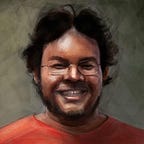Notes from Basics of Screenwriting Workshop conducted by Al-Jafree Md Yusop on August 4–5, 2018 at Penang Youth Centre organized by Komuniti Filem Titiwangsa (KOMFIT) and Majlis Bandaraya Pulau Pinang.
1. Script is the blueprint for TV, film, theatre, etc. Without script, none of the pre/production/post work exist.
2. Screenplay (lakonlayar) is for film, teleplay is for TV.
3. Types of story:
i) Horizontal storytelling (Plot driven e.g. Star Wars)
ii) Vertical storytelling (Character driven e.g. Before Sunrise)
iii) Open story- clear plot, characters, etc.
iv) Closed story- vague plot, characters, etc.
4. Drama- conflicts resolved by discussion/conversation. Melodrama- conflicts resolved by action/non-verbal.
5. Write the script as writer, not director. Forget camera shots, angle, etc. Those comes after.
6. Director can be manipulative to carry the story e.g. hiding weird props from casts to capture their spontaneous reaction during first take.
7. Many great directors started as script writer e.g. Coppola, Kurosawa, Cameron. Great directors are writers themselves.
8. Local scriptwriters don’t get the credit/pay they deserve. Some American writers even credited as their film’s producers.
9. A writer has to know the Basics of Acting to write a good dialogue.
10. Justify props inside a frame. Also for budgeting. Set, wardrobe makes a difference in acting. e.g. when brought in a piano for Mencari Rahmat’s rehearsal, casts became more convincing acting as a wealthy character.
11. Writer has to know the film’s subject matter. Research. e.g. Cast Away writer Bill Broyles Jr. stayed on a Mexican island with nothing and learned to survive for 10 days.
12. Idea → Story → Script
13. ‘Story’ is what it is about. ‘Plot’ is how it is being told.
14. Justify why the story has to be told.
15. Death is very “sexy” for a story. Makes a good motivation.
16. On “sex and violence”- not graphic sex and violence, but a version of it.
17. How to train your mind for good storytelling:
i) Watch a lot of good movies
ii) Read a lot of books
iii) Listen to a lot of music
iv) Watch theatre/play
v) Visit galleries and appreciate fine art
vi) Travel and learn different cultures
vii) Know politics
18. Good story opens up your audience’s mind.
19. Pacing can be made/fixed during writing. Good pacing is not just about editing and timing.
20. Open film with big question mark to make audience think. Thinking audience/capturing their attention is good pacing.
21. Treatment types:
i) Essay treatment
ii) Step outline (point form)
iii) Scene by scene treatment (write the scenes first, dialogue later)
22. Storytelling structure:
23. On market/formula for box office- What do we know about market/trend? Even the audience doesn’t know what they want/like e.g. Jaws, Star Wars broke stereotypes and made box office.
24. If you know How to Read Films, you’ll get different/better watching experience.
25. Film students have dogma/rules of filmmaking. Greatest filmmakers didn’t go to film school- Kubrick, Spielberg, Tarantino, Fincher, Jackson, Cameron. They broke the rules.
26. When writing, keep an open mind. Don’t judge your characters.
27. On plagiarism- they cannot copy our soul/feel that produced the original piece, so their version can’t beat ours e.g. Gus Van Sant shot-by-shot version of Hitchcock’s Psycho.
28. Everyone has their own story. Find an angle. The best story is the one you know best about/ about yourself.
29. A lot of public domain stories can be used for free.
30. People who speaks/understands Malay language is roughly 300 mil (250 Indonesia, 30 Malaysia, Brunei, Singapore), so Malay market is huge.
31. Film has become commodity in USA. Film is an important medium. Art is humanity.
32. Good books on screenwriting- Screenplay by Syd Field, Screenwriting 434 by Lee Hunter, The Writer’s Journey by Christopher Vogler.
33. Films with good screenplay- Network (Sidney Lumet) by Paddy Chayefsky, E.T. (Steven Spielberg) by Melissa Mathison, Butch Cassidy and the Sundance Kid (George Roy Hill) by William Goldman, Chinatown (Roman Polanski) by Robert Towne, The Princess Bride (Rob Reiner) by William Goldman.
34. Al-Jafree’s fav films to watch- Billy Wilder’s The Apartment, Francois Truffaut’s 400 Blows, Curtis Hanson’s L.A. Confidential, Sidney Lumet’s 12 Angry Men, Asghar Farhadi’s A Separation.
For more info on KOMFIT’s next workshop, follow their Facebook page.
(Anyone who attended the workshop reading this, if you find any mistakes in my notes please comment below and I will correct them. Thank you for reading.)
